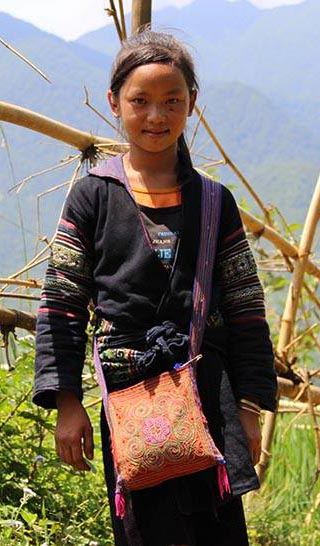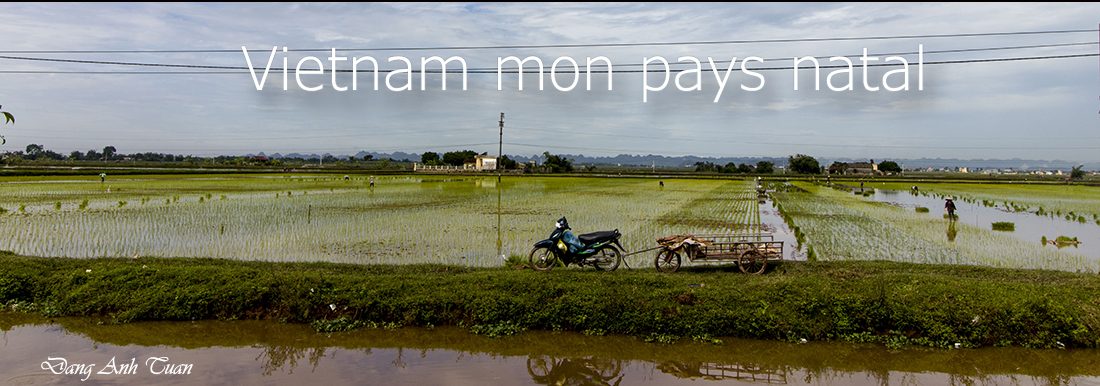Version anglaise
Version française
Màu chàm là màu căn bản thường được trọng dụng bởi các phụ nữ Hmong trong việc nhuộm quần áo. Trước đó các y phục nầy được sáng chế từ các cây gai dầu mà họ trồng, rồi họ tự dệt lấy và nhuộm màu chàm sau cùng một cách tự nhiên. Những phụ nữ Hmong được xem là những phụ nữ khéo tay. Màu xanh tuyệt vời này tô điểm cuộc sống của họ đã từ bao năm nay.
Dệt và thêu là các công việc chính của các phụ nữ Hmong. Chính vì lý do này mà họ phải học may từ thưở nhỏ (6 hoặc 7 tuổi) với mẹ. Khi trưởng thành, họ hoàn toàn biết may vá quần áo để thể hiện không chỉ họ có khả năng thành thạo trong việc làm mà còn thể hiện được sự giàu có và cấp bậc mà gia đình họ có ở trong làng. Đó cũng là một cách để quyến rũ và giữ được sự chú ý của các chàng trai trẻ và cha mẹ của họ trong trường hợp đi đến chuyện hôn nhân.
Thành ngữ sau đây biểu lộ định kiến mà được duy trì từ lâu ở trong xã hội Hmong:
Gái xinh chưa biết cầm kim là hư.
Những bộ đồ sặc sỡ, những tác phẩm thêu thùa trang nhã và những trang sức tinh xảo làm họ có tiếng tăm ở khắp vùng Đông Nam Á. Đây cũng là biểu tượng độc đáo của bản sắc của dân tộc Hmong.
Người Hmong là một dân tộc không có quốc gia. Tuy nhiên, họ là một dân tộc rất cổ xưa, có nguồn gốc từ Trung Quốc và liên tục bị đàn áp và đẩy lùi bởi những người phương Bắc trong nhiều thế kỷ để trở thành một trong những dân tộc thiểu số của Việt Nam ngày nay. Việc trưng bày trang phục và đồ trang trí của họ có liên quan đến cái tên được gọi là « dân tộc đa sắc » như cái cầu vòng mà có một số người tiếp tục gán cho dân tộc Hmong.
Un peuple en quête de liberté.© Đặng Anh Tuấn
Version française
L’indigo est à la base de la teinture employée par les femmes Hmong dans la confection de leurs vêtements. Ceux-ci sont en chanvre cultivé et tissé par elles-mêmes. Ils sont teintés par l’indigo obtenu de façon naturelle. On dit que les femmes Hmong ont la main bleue. Ce superbe bleu colore bien leur vie depuis longtemps. Tissage et broderie sont les tâches principales des femmes Hmong. C’est pour cette raison qu’elles doivent apprendre à coudre dès leur jeune âge (6 ou 7 ans) auprès de leurs mères. Une fois adultes, elles maîtrisent parfaitement la confection pour montrer non seulement leur aptitude au travail, leur savoir-faire mais aussi la richesse et le rang de leurs familles dans le village. C’est aussi une façon de séduire et de retenir l’attention des garçons ainsi que celle de leurs parents en cas du mariage.
L’idiome Hmong suivant:
Gái xinh chưa biết cầm kim là hư
Une jolie fille ne sachant pas manipuler une aiguille est méprisable.
témoigne du préjugé entretenu dans la société Hmong.

Les costumes bigarrés, les broderies élégantes et les bijoux fins font incontestablement leur réputation à travers l’Asie du Sud-Est. C’est aussi le symbole unique de leur identité.
Les Hmong constituent un peuple sans nation. Pourtant c’est un peuple très ancien, originaire de la Chine et refoulé sans cesse par les gens du Nord au fil des siècles pour devenir aujourd’hui l’une des minorités ethniques du Vietnam. L’exhibition de leurs costumes et de leurs parures n’est pas étrangère à la dénomination « peuple arc-en-ciel » que certains continuent à attribuer aux Hmong.
Version anglaise
The indigo underlies the dye used by the Hmong women in their clothing manufacture. These are made of hemp grown and woven by themselves. They are colored by the indigo obtained in a natural way. It is said that the Hmong women have the blue hand. This beautiful blue colours well their lives for a long time.
Weaving and embroidery are the main tasks of Hmong women. It is for this reason that they must learn how to sew from their young age (6 or 7 years) with their mothers. As adults, they have perfectly mastered the making clothing to show not only their ability to work and their know-how but also the wealth and status of their families in the village. It is also a way to seduce and to retain the boys attention as well as that of their parents in the event of marriage.
The Hmong idiom following:
Gái xinh chưa biết cầm kim là hư
A pretty girl not knowing manipulate a needle is despicable.
testifies to the bias maintained in the Hmong society.
a people in search of freedom
Funny costumes, elegant embroideries and fine jewelries incontestably build their reputation through the South-East Asia. It is also the unique symbol of their identity. The Hmong are a people without nation. It is a people very old, originating in China and repulsed without delay by the North people over the centuries to become today one of the ethnic minorities of Vietnam. The exhibition of their costumes and ornaments is not foreign to the name “rainbow people ” that some people continues to assign to the Hmong.

